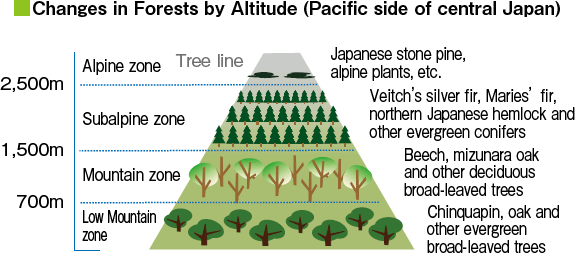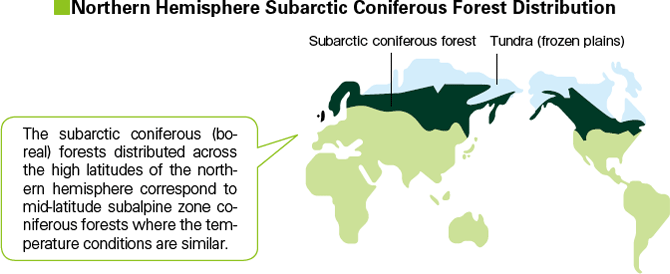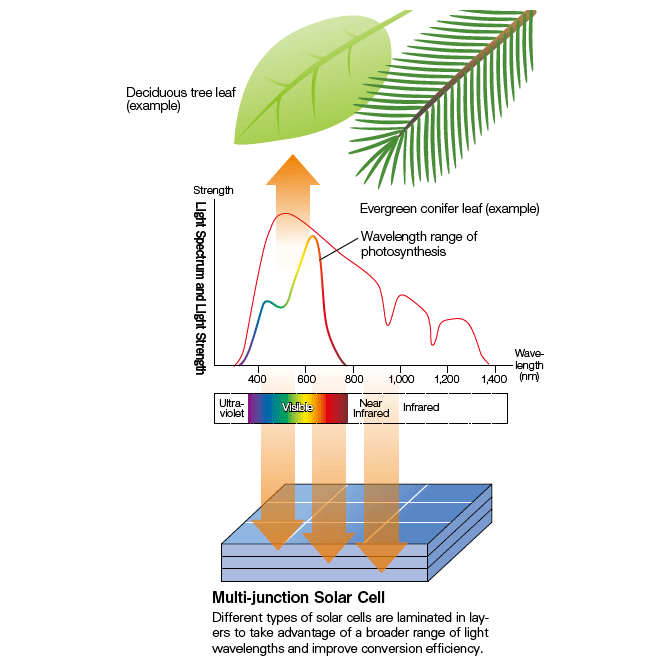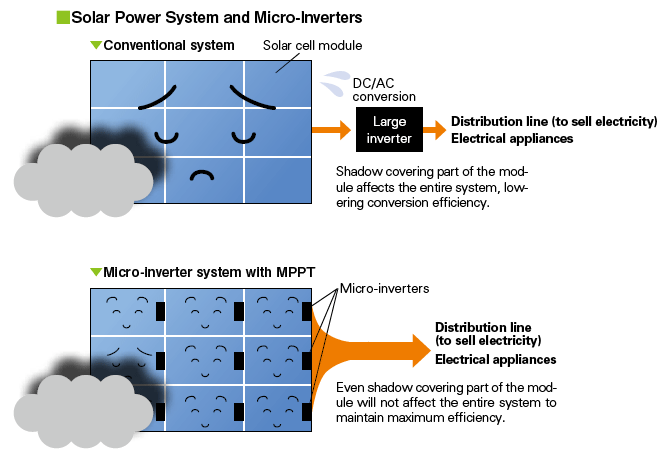- Tech-Mag Home > The Wonders of Nature > The Earth's Forests and Solar Power Performance
The 3rd edition Low-Profile Film Capacitors
The Earth's Forests and Solar Power Performance

In generating solar power, system efficiency depends on more than just a high-efficiency solar cell. Equally as important is the installation's power supply, which includes an inverter to transform direct current into alternating current.
TDK has recently developed low-profile film capacitors ideally suited for cutting-edge micro-inverters.
Forests types differ by latitude and altitude
When climbing a high mountain one becomes aware of changes in the type of forest one sees at different altitudes. In the mountains of central Japan on the Pacific Ocean side, on level ground and at the base of the mountains one finds evergreen broad-leaved trees such as chinquapin and oak. As one climbs, the landscape shifts to predominantly deciduous broadleaved trees such as beech and mizunara oak. The subalpine zone is defined by an elevation of 1,500 to 2,500 meters, where dense forests consist primarily of evergreen conifers such as Veitch's silver fir, Maries' fir, and northern Japanese hemlock.These differences in tree species are largely due to atmospheric temperature. For every 100 meters in altitude the air temperature will drop 0.5 to 0.6 KC. At 2,000 meters the temperature is approximately 10 KC lower than at sea level.
This vertical distribution of forests is similar to the horizontal distribution of forests by latitude. Coniferous forests of the subalpine zone are similar in nature to the subarctic coniferous (boreal) forests of high-latitude regions such as the tiaga. Just as a mountain has a tree line above which trees do not grow, as one approaches the polar region the subarctic coniferous forest ends and the tundra begins, a permafrost zone where only moss and lichens can grow.
The Japanese archipelago is long and narrow north to south, with steep mountain ranges that offer a varied distribution of forests. More people these days are traveling to enjoy forests or climb mountains.


Improving solar cell conversion efficiency using a broad wavelength range
Forests of evergreen conifers are found in subalpine and subarctic zones where the temperature is lower than in low mountain areas and temperate latitudes. Different species of trees have developed different survival strategies depending on the climate. Plants use solar energy and absorb water and CO2 to produce organic tissue and grow. The greater the area of its leaves, the more effective the process of photosynthesis. However, when temperatures drop below freezing, leaves will suffer frost damage. Deciduous broad-leaved trees thus take advantage of the warm, sunny seasons from spring to autumn by spreading their leaves to allow as much photosynthesis as possible to take place; then they lose their leaves and become dormant as winter approaches. In contrast, the evergreen conifers that grow in subalpine and subarctic zones employ a strategy of photosynthesizing all year round. Little moisture evaporates from their thin, stiff, needle-like leaves, as protection from frost damage. And to utilize the sun's rays more efficiently, chloroplasts are densely concentrated, so the green color of conifers is deeper than that of deciduous tree leaves.
Photosynthesis converts light energy into chemical energy. In manmade solar power systems, solar cells convert light into electrical energy. These solar cells used to generate power are made of various materials, such as monocrystalline silicon, polycrystalline silicon, and amorphous silicon. None of these materials, though, covers as broad a wavelength range as natural photosynthesis. In recent years, the solar power industry has begun R&D on multi-junction solar cells that use stacked layers of different types of solar cells to take in a broader range of light wavelengths than even natural photosynthesis.

Ideal low-profile film capacitors for solar micro-inverters
In solar power systems, modules that contain multiple solar cells are connected either in series or in parallel, and an inverter converts the current and sends it to electrical appliances or out to the electric company. The system's output depends only partially on the strength of the incoming light. Output is also affected by temperature and other factors, so being able to transfer energy at the maximum power point (MPP) is linked to higher efficiency. In recent years systems have been developed that use maximum power point tracking (MPPT), which relies on a microinverter built into each module to keep the system overall from being affected by a portion of the solar panels being in shadow.
A micro-inverter requires low-profile electronic components, and so TDK developed low-profile film capacitors for this purpose. These components are only 15 mm and 19 mm in height while offering superb characteristics and high reliability. They are also ideal for equipment on board a vehicle as they are highly resistant to vibration and shock.


Low-Profile Film Capacitors
Film capacitors are widely used in converters, inverters, and power circuits for their insulating properties and high reliability.
TDK's new low-profile film capacitors have been made as slim as 15 mm and 19 mm in height.
They are ideal for solar microinverters, flat TVs, induction cooktops, LED lighting, and other applications that require low-profile components.

Flat, just 15 mm and 19 mm in height.
Comes in two types: the MKP model uses PET (polyethylene terephthalate) for the dielectric material, while the MKT model uses PP (polypropylene).





